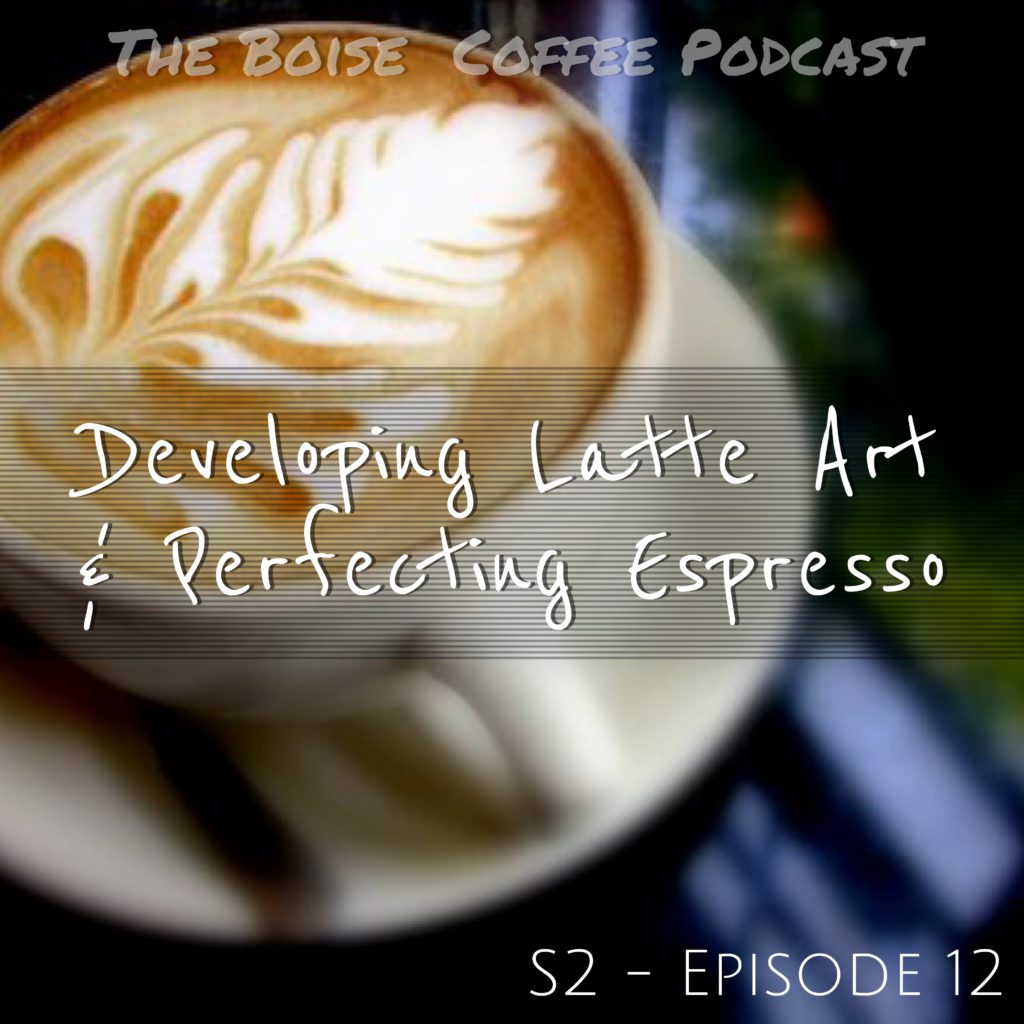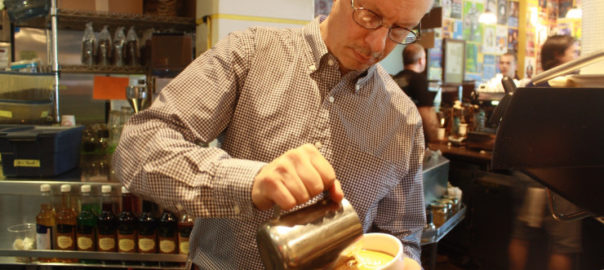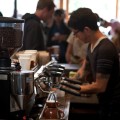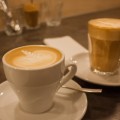
Making coffee is as much an art as it is a science. As with any culinary endeavor, the amount of time and energy you put into the ingredients, the preparation, the creation, and the presentation of a cup of coffee or espresso, the better the end product will be. The ingredients of a cup of coffee start at the farm where coffee beans are grown and continues through the processing, storing, and roasting.
As I discussed last episode, any one misstep in this enormous supply chain will leave you with a sour, bitter cup of coffee. But there’s more to it than just ingredients – preparation plays a huge role as well. If a perfect batch of roasted beans makes it into the hands of an untrained or careless barista, you won’t get the variety of flavors and complexity in your end product. Finally, there’s presentation to be considered. As much as I’d like to tell you that the environment and atmosphere where you drink your coffee, together with how the coffee itself looks, doesn’t impact taste, I’d be lying. There’s a reason why high-quality filet mignon isn’t served in a styrofoam carryout box and fine wine doesn’t arrive at your table in a red solo cup. We human beings care a great deal about how something looks – and we make judgement calls about how food and drink tastes before it ever touches our lips.
In 1988 Espresso Vivace opened. Its founder is an overqualified eclectic scientist named David Schomer. Schomer’s path to coffee is as winding as they come – he spent four years in the U.S. Air Force, training in electronic calibration and repair, then a stint as a metrologist (the science of measurement) at the Boeing Class A Standards Lab. For a time he was the Canvas Coordinator for Greenpeace NW, and he holds a BA in Cultural Anthropology and a BFA in Flute Performance from the Cornish College of the Arts. In short, he’s both an artist, and a scientist.
This episode of The Boise Coffee Podcast is brought to you by WMF Coffee Machines. WMF is the leading international manufacturer of fully automatic commercial coffee machines, and they’re proudly made in Germany. Whether you’re looking for a simple office machine, or robust professional barista-grade equipment, WMF has what you’re looking for. Visit wmf-coffeemachines.uk.com to find out more.
Colin
Check out David Schomer’s 2014 TEDx talk here.
Episode transcript:
This episode of The Boise Coffee Podcast is brought to you by WMF Coffee Machines. WMF is the leading international manufacturer of fully automatic commercial coffee machines, and they’re proudly made in Germany. To find out more, visit wmf-coffeemachines.uk.com
Making coffee is as much an art as it is a science. As with any culinary endeavor, the amount of time and energy you put into the ingredients, the preparation, the creation, and the presentation of a cup of coffee or espresso, the better the end product will be. The ingredients of a cup of coffee start at the farm where coffee beans are grown and continues through the processing, storing, and roasting. As I discussed last episode, any one misstep in this enormous supply chain will leave you with a sour, bitter cup of coffee. But there’s more to it than just ingredients – preparation plays a huge role as well. If a perfect batch of roasted beans makes it into the hands of an untrained or careless barista, you won’t get the variety of flavors and complexity in your end product. Finally, there’s presentation to be considered. As much as I’d like to tell you that the environment and atmosphere where you drink your coffee, together with how the coffee itself looks, doesn’t impact taste, I’d be lying. There’s a reason why high-quality filet mignon isn’t served in a styrofoam carryout box and fine wine doesn’t arrive at your table in a red solo cup. We human beings care a great deal about how something looks – and we make judgement calls about how food and drink tastes before it ever touches our lips.
I’m Colin Mansfield, and welcome to the Boise Coffee Podcast
—Boise Coffee Podcast Theme—
In the 1980s coffee companies began springing up all across Seattle, Washington. In 1982 Howard Schulz became the CEO of a promising coffee chain named Starbucks, and focused on expanding. As we know, he succeeded – by 1994 there were over 400 locations. But Starbucks is far from the only successful or meaningful coffee company to be birthed from the overcast counter-culture friendly environment found in Seattle. In 1988 Espresso Vivace opened. It’s founder is an overqualified eclectic scientist named David Schomer. Schomer’s path to coffee is as winding as they come – he spent four years in the U.S. Air Force, training in electronic calibration and repair, then a stint as a metrologist (the science of measurement) at the Boeing Class A Standards Lab. For a time he was the Canvas Coordinator for Greenpeace NW, and he holds a BA in Cultural Anthropology and a BFA in Flute Performance from the Cornish College of the Arts. In short, he’s both an artist, and a scientist. He’s spent the last 30 years concerning himself with the preparation and presentation of espresso-based beverages and is widely considered to be the man who pushed and perfected espresso, paving the way for the worldwide specialty coffee culture. He’s also the man credited with bringing latte art to the US and inventing several of the delicate patterns that we’re familiar with today.
For as popular as espresso became in the 1980s and 1990s, not a lot of thought had been put into how to make it better. In many ways it was the wild west of specialty coffee – drinks like the latte and macchiato hadn’t yet hit the main stream, and there was no real standard to judge any particular drink against. To make matters worse, the common thought amongst coffee shop owners was that the variables that go into making coffee were so varied and complex that no matter what you did to perfect your technique and maintain consistent quality, each drink would taste different. These variables include grind size, dosing size, tamping pressure, brew time, and many many more. David Schomer, however, wasn’t fazed. He set out to create the perfect shot of espresso.
David put it like this – coffee should taste like it smells. He believed that the intoxicating, complicated rush of aromas that hits you right after you open up a bag of fresh coffee should be present in each shot of espresso. That single notion pushed Schomer to travel to the mecca of Espresso; and so, in 1989, he set off to Northern Italy.
David’s coffee research trip through Italy included testing coffee, watching how shots are pulled, and watching how drinks are made in about 400 different shops. This trip, combined with a second that he took in the early 90s, was instrumental in solidifying David’s plan to get the smell of coffee into the end product. Not only did he learn that indeed, the variables inherent in the brewing process are the limiting factors to how good a shot of espresso can taste, he also was exposed to and fell in love with latte art. More on that in a minute.
Over the next decade David began perfecting each and every variable that goes into pulling a shot of espresso. He brought in employees, many of which still work at Espresso Vivace to today, and created an environment where great coffee wasn’t the goal, it was the norm. But even as he began approaching near-perfection in the manual steps associated with making espresso, he still wasn’t satisfied with the way his shots tasted. He hadn’t yet achieved putting the smell of coffee into the taste. He started looking at the automatic steps that most baristas take for granted – namely, water temperature. He knew that temperature played a huge role in brewing, and he knew that 203 degrees Fahrenheit was the optimal point for espresso machines to brew with. But what if that temperature wasn’t being held constant throughout the brewing process? What if there were fluctuations that weren’t being accounted for or controlled?
David returned to his metrologist roots and began experimenting with his own machine to find out whether or not the brewing temperature was being held constant. He rigged up a digital thermometer to one of his portafilters, and set out across the west coast to find out if he was right – and he was. He found out that across the board, all professional espresso machines had temperature variances somewhere between 6 degrees and 20 degrees, and it made him furious. In a 2014 TEDx talk, Schomer said, “a $39 Mr. Coffee has better control than these $10,000 machines that are all over the place.” He wrote about this huge problem in a series of articles titled “Engineered Mediocrity” but the coffee community simply wasn’t listening.
In 1995 Schomer experimented on his own La Marzocco espresso machine and was able to fix its brewing temperature to within 2 degrees of the optimal 203 degrees Fahrenheit. But, by his own estimations, this wasn’t good enough. Through testing and measuring he determined that the taste of espresso was impacted by as small as a 1/10th degree of change in brewing temperature. If he could attain a half degree variance, it would put him in the right ballpark for attaining perfect espresso, but two degrees was simply unacceptable. So he continued to push. It took David six more years until he found a way to fix this problem. The solution, after the break.
—Ad Break—
This episode of The Boise Coffee Podcast is brought to you by WMF Coffee Machines. Their fully automatic commercial coffee machines are made with the highest quality materials, and their product line covers a broad spectrum of needs. Whether you’re a small business or a large corporation, WMF is dedicated to providing you with easily maintained equipment that produces high quality, fresh coffee no matter who is operating it. Their most recent, next-gen coffee machine is the WMF 5000S, capable of making 250 cups per day and equipped with a simple, touchscreen interface. With three hoppers for espresso beans, decaf, and hot chocolate, the WMF 5000S can make up to 42 different drinks, each of which is fully customizable on-the-fly. And for longer meetings, you can even brew a full pot of coffee. To find out more about the 5000S or any of the high quality coffee machines that WMF offers, visit wmf-coffeemachines.uk.com
—Ad Break Finished—
On February 28th, 2001, David Schomer solved the temperature problem. Together with Roger Whitman of La Marzocco and John Bicht of Versalab, he took an omega PID controller – a computerized thermostat – and stabilized the brewing temperature of an espresso machine to 203 degrees Fahrenheit with a half a degree of error, for the first time in human history. Over time, his findings and solution rippled across the coffee community, and today, every espresso machine has a PID controller built in. Not only that, but espresso machine manufacturers and coffee shop owners are constantly looking for new ways to attain an even higher degree of temperature consistency. A barista can always work hard and perfect their technique, but it won’t matter if their equipment doesn’t perform at the highest possible levels.
Solving the variable problem wasn’t the only thing David brought back from that 1989 Italian coffee crawl, however. As I briefly mentioned, latte art was another huge aspect of coffee that Espresso Vivace popularized with Schomer at the helm. Latte art isn’t simply a pretty way to display coffee, however – it’s also the mark of well-steamed milk. The act of heating and steaming milk isn’t hard. Doing it well is. Poorly steamed milk can be either too bubbly and airy, resulting in a head of foam that makes getting to the “coffee” part of your beverage a difficult task, or flat and uninteresting. Well steamed milk has a rich, velvety texture that’s viscous, yet smooth. It contains tiny bubbles, called microfoam, that makes drinking your latte or macchiato a pleasant experience, with rich milky goodness and espresso mixed evenly.
When steamed properly, the milk and microfoam can be poured into a cup containing espresso in such a way that the barista is able to create interesting and unique patterns on top of your drink. In the early days of latte art at Vivace, David and his employees were trying to come up with as many designs as possible. In fact, David bet one of his baristas, Lisa Parson, $50 that she couldn’t make a heart using latte art. Not a good bet.
Today, you can find a variety of different latte art designs from coffee shops all over the world. Some of the most common are the rosetta – which resembles a leaflike or fern pattern, swans, fossils, and of course – hearts. More complicated designs mix these patterns, creating designs like swirls and wreathes.
Over the years, latte art has become a source of competition between baristas across the globe. There are many regional, national, and international competitions that aspiring latte artists can compete in, including Coffee Fest and the World Latte Art Championship founded by the Specialty Coffee Associations of Europe and America. This year’s World Latte Art Championship is being held in Shanghai and has 37 competitors from all over the world. David Schomer himself has judged latte art competitions at the Coffee Fest championships, according to a Barista Magazine post in 2013.
Latte art isn’t the only kind of competitive coffee making out there; many coffee trade shows and conventions host variations of espresso competitions. Sometimes these are done solo, with individual baristas directly competing for who can pull the best shot. Other times, it’s a group effort. At a coffee convention I attended a few years ago, a coffee shop environment was simulated, with teams competing against each other; they were judged on quickness of service, accuracy of orders, quality of product, and a “special drink” that each team was asked to invent.
In a 2015 Seattle Times article, Schomer commented on these espresso competitions, saying “The critical thing is that I’m in a happiness business. I’m here to make you happy. I want to know what you want and I make it as quick and as fast as I can. The espresso contest kind of sets up these young people to fail. It makes them feel like some kind of a rock star or something. And the customer is kind of left behind. I don’t like that.”
David’s point is salient, given his many years in the industry, but it also gives us a look into the heart behind his passion: he’s there to create a good experience for the customer. If a barista pulls an absolutely perfect shot with a PID controlled machine and flawless form, it matters little if the customer isn’t happy. This is important because coffee, like anything else, is a business. David Schomer isn’t influential because he invented a way to make better espresso, or because he introduced latte art to the U.S. His influence comes from a deep-set desire to create a positive environment for anyone entering his shop, and he’s been immensely successful at that. Like all baristas, he’s not really in the coffee business. He’s in the happiness business.
Getting coffee from the ground to your cup takes science, engineering, logistical management, expertise, trial and error, and tenacity. The beans that make up the beverage in your mug pass through the hands of tens, maybe hundreds of dedicated individuals. But as we’ve seen, it’s also an art. Baristas, roasters, and coffee shop owners spend years perfecting the way they make coffee and deciding how they want to present it. They create the ambiance of their shop and teach new employees the best way to approach talking to a customer to make their product desirable for you. This $46 billion industry, this intersection of art and science — it all hinges on making you, the customer, feel welcome and happy about your drink. At the risk of asking you to go through an existential crisis, the next time you’re holding a cup of coffee fresh from your local shop, ask yourself: are you happy?
Thanks for listening to The Boise Coffee Podcast. As always I’m your host, Colin Mansfield, and I really appreciate your support. Thanks to the listeners who have contacted me and shared the show recently – shoutout to Barry from Maryland.
If you liked this episode, please go on iTunes and give me a review. If you’d like to contact me, you can shoot me an email at BoiseCoffee@gmail.com or reach out to my on Twitter; my handle is @BoiseCoffee. Finally, if you’d like to listen to other episodes of the show, you can find them on iTunes, Stitcher, SoundCloud, or my blog – BoiseCoffee.org.
This episode of The Boise Coffee Podcast was brought to you by WMF Coffee Machines. Whether you’re looking for a simple office machine or robust professional barista grade equipment, WMF has what you’re looking for. Visit wmf-coffeemachines.uk.com to find out more.
Thanks for listening, and have a great rest of your week.
Podcast: Play in new window | Download
Subscribe: Apple Podcasts | Android | Stitcher | RSS



